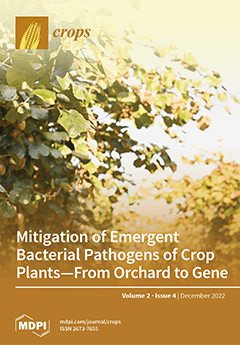Drought stress negatively affects plant growth and development, thus reducing plant productivity. Therefore, understanding the molecular mechanisms underlying drought stress responses is essential for crop improvement. The plant-specific NAM/ATAF1,2/CUC2 (NAC) transcription factors play important roles in the drought stress response. Here, we show
[...] Read more.
Drought stress negatively affects plant growth and development, thus reducing plant productivity. Therefore, understanding the molecular mechanisms underlying drought stress responses is essential for crop improvement. The plant-specific NAM/ATAF1,2/CUC2 (NAC) transcription factors play important roles in the drought stress response. Here, we show that rice (
Oryza sativa) ONAC054, a membrane-bound NAC transcription factor, is involved in the drought stress response. We found that
onac054 mutants were sensitive, whereas
ONAC054-overexpressing (
ONAC054-OX) plants were tolerant to drought stress. Under drought stress conditions, several genes associated with abscisic acid (ABA) synthesis and signaling were downregulated in
onac054 mutants but upregulated in
ONAC054-OX plants. Among these genes, the
TRANSCRIPTION FACTOR RESPONSIBLE FOR ABA REGULATION 1 (
TRAB1), which encodes an ABA-inducible bZIP transcription factor, was directly activated by ONAC054. On the other hand, the expression of
ONAC054 was directly activated by several ABA-responsive elements (ABRE)-binding factors (ABFs) in an ABA-dependent manner, indicating that ONAC054 acts as an enhancer of ABA-induced drought stress tolerance. Additionally, the overexpression of
ONAC054 in rice greatly improved grain yield under drought stress conditions, indicating that the overexpression of
ONAC054 could facilitate the improvement of drought stress tolerance in rice and other crops.
Full article





